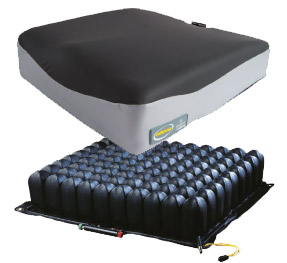- When selecting a cushion, consider the following in order:
1) Pressure Management
2) Positioning Needs
3) Transfer Technique
4) Maintenance
Pressure Management
The ability of the cushion to distribute loads across the entire sitting surface and to conform to bony prominences while equalizing pressure in surrounding areas.
Positioning Needs
Lateral Stability – The ability of the cushion to support the pelvis and maintain its current position as the upper body moves forward through the coronal plane, as well as its to assist in preventing the pelvis from sliding forward along the cushion during such activities as foot propulsion or weight shifting.
Forward Stability – The ability of the cushion to promote a neutral pelvis during an upper body forward motion as well as its ability to assist the pelvis maintain neutral as the upper body returns to its home position along the coronal plane.
Transfer Technique
Generally, the better the pressure care, the harder it is to perform a sliding transfer onto a cushion. Positioning cushions with inserts designed to improve lateral stability also can be a challenge to a side transfer. Positioning cushions require good placement for optimal pressure care – a special consideration if the client has limited sensation or is dependant on others to position them.
Maintenance
- Many gel cushions require daily massage of the gel to avoid bottoming out.
- Air cushions need to be checked for pressure regulation. (Is your client in an environment where this will happen?)
With the above in mind, here is a comparison of some of the most proven pressure relief cushions:

